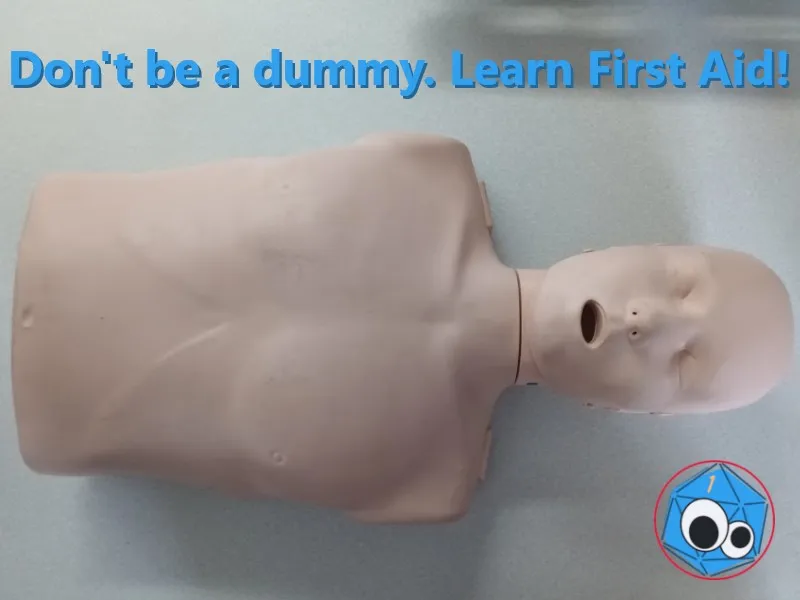Today was CPR and First Aid training day at the library. A fire department paramedic and instructor was supposed to teach over a dozen of us district librarians how to help people not die before help arrives.
The instructor was late.
Apparently wires got crossed, this particular day wasn't on his schedule, and he was busy elsewhere. Fortunately, he wasn't called out on an emergency. Unfortunately, the class was delayed for an hour as we waited for him to arrive. Uffda.
Eventually, though, a middle-aged firefighter with a horseshoe mustache that would make Hulk Hogan envious finally arrived with bags of dummies and a slide show. This instructor is a lot more fun than Laptop with a PowerPoint might imply. In order to help myself retain what we covered, and hopefully encourage you to seek more complete training, here's the basics.

First Aid
As I have said before, in any emergency situation you encounter, you are the first responder. Knowing how to render aid when you are there on the scene of an incident means people have a far better chance of living long enough for the pros to arrive, assess, and act. Until then, lives are in your hands. You don't have a duty to learn how to help in an emergency, but I strongly advise at least learning the basics.
- Start the breathing.
- Stop the bleeding.
- Control shock.
If you can keep blood flowing where it needs to go, and keep it from flowing where it shouldn't—anywhere outside the body is a good start—you'll be able to significantly improve the odds of someone surviving a medical emergency. Ideally, you will have access to sterile bandages, a surgical mask, gloves, shears, tourniquets, and more. If not, be ready to improvise.
Additionally, be prepares to take charge of the situation. If you realize something is wrong, take action and issue instructions. Ask someone to call 911. Ask someone to clear bystanders. Send someone to fetch a first aid kit. If someone more skilled and experienced shows up, fine. If not, be prepared to be that someone.
CPR
Cardiopulmonary resuscitation (CPR) can be complex, but it does not have to be. At the most basic, it just means chest compressions to manually pump blood through the victim's body so organs don't start to fail. Even rescue breathing isn't essential, so although it may help depending on the situation, it is not considered part of basic CPR.
The blood in someone's system is already at least partially oxygenated, so keeping it flowing is key. Compressing the chest can also help some air flow into the lungs if the airway is not obstructed. Even as that oxygen level diminishes, there is still a benefit to keeping it circulating.
The method is fairly simple.
Expose the victim's chest. This ensures proper hand placement, and makes possible additional procedures like defibrillation easier.
Place the heel of one hand on the victim's sternum and on the nipple line. Obviously, well-endowed women and obese folks in general may require a looser interpretation. Estimate just below the midpoint of the sternum in such circumstances.
Firmly compress the chest. Place your other hand over the first, keep your arms stiff, and rotate at the hips. Compress to a depth of 2-2.4" (5-6 cm) at a rate of 100-110 compressions per minute.
This should be continued until the victim recovers consciousness, help arrives, or you give out physically. Chest compressions are a lot of work, so if there is an emergency, and if there is anyone else around, describe what you are doing and demonstrate so they can hopefully relieve you and let you rest a moment.
There are also a couple songs that might help you keep the right rhythm. Just.. don't sing the second one out loud, OK? It's bad for morale.
Queen - Another One Bites the Dust

More info from Mayo Clinic here.
AED
An Automated External Defibrillator is a neat box of electronics that can help diagnose cardiac arrest and, if appropriate, deliver an electric shock to a heart in fibrillation to defibrillate it, and hopefully restore the normal cycle of healthy beats.
Devices vary, but in essence, they're all fundamentally the same. Open the box, follow the graphics, and listen to the automated voice as it gives instructions. Remember when we exposed the patient's chest for CPR? That's partly in case of needing to apply the pads for an AED. Also, note that neither underwire bras nor body jewelry play nice with electricity. A bra should be gone already, but if not, remove it as best you can. Kits usually have shears. Jewelry may be difficult or impossible to remove, so don't waste time if you can't get it sorted quickly. Better burns and prompt care than no burns and delayed care.
If someone is exceptionally hairy, the pads may not stick. An AED usually includes a razor for emergency shaving. Alternatively, if there are multiple sets of pads, use the first to rip out hair if necessary. If someone is... large... then look for a way to separate the pads. Some systems have separate pads already. Others are linked, but one or both can be removed from a velcro strip to extend the range.
Take a class and this will all be explained further. Check with your fire department and see if they have an outreach program.
Choking
Hollywood does a terrible job of portraying lots of things, including CPR and choking. People rarely make the universal sign for choking. Some may stand up in an odd posture, while others may bend over and be harder to see. I have little advice here beyond situational awareness, although hearing someone saying, "Hey, I think this guy is choking! Help!" is a solid clue.
The Heimlich Maneuver is a method of dislodging an airway obstruction by wrapping your arms around the choking victim, placing your fist at their solar plexus, and forcefully compressing their guts in and up to blast the blockage. Shoot for across the room.
If they are too big for you to reach around them, maybe you can use the back of a chair as the pressure point. If it is a pregnant woman, the better option would be the CPR sternum point instead. Less effective, but safer.
More info from Mayo Clinic here. In fact, I suggest their resources on all further first aid topics, too.
Bleeding
Blood belongs on the inside. When blood is on the outside, something is wrong. Internal bleeding is also bad, because blood may still be inside, but not where it belongs. That's outside the scope of bystander aid, though. If you can see it, try to do something about it.
- Apply direct pressure. Use a clean cloth and press on the wound to stem the flow of blood. This fixes a lot of minor injuries.
- Apply a compression bandage. If you can, tie cloth around your bandage to maintain pressure.
- Elevate the wound. If you can raise the leaky place above the heart, gravity fights the heart's pump and slows the flow.
- Apply a tourniquet. Back in the day, as in 20 years ago, all the experts said tourniquets were a last resort. Nowadays, that's less of a concern. Even a few hours of tourniquet use on a limb doesn't mean guaranteed amputation. If the other methods aren't working, bind the arm or leg close to the respective armpit or groin and twist a stick in the knot until the blood stops gushing.
Shock
In first aid, shock means a physiological response to trauma, not feeling surprised. The body is responding to injury, and this can result in lots of problems. Due to blood loss or other medical problems, things are shutting down. In general, if the face is pale, raise the tail. If the face is red, raise the head. Ensure your patient is resting comfortably. Provide a blanket. this is mainly a process of attending to the patent's comfort and care until help arrives.
Seizures
Basically, guide the patient to the ground if you can to prevent them from taking a worse spill, ensure the area is safe by removing hazards, call for help, and wait it out. If you think of it, note the time you noticed the onset. Unless you notice a problem with breathing or bleeding, just do what you can to keep them from hurting themselves.

That pretty much covers the basics. We didn't cover broken bones or poisonings. I skipped drug overdoses and other special circumstances we discussed, and I want to reiterate our afternoon was just covering the basics, so again, get training! reading a blog post ain't prepping. Check with the Red Cross, your fire department, and scouting organizations, as all may be able to help to one degree or another. Learn now, and possibly save a life later. Whether you are in a public space or out in the wilderness, the ability to render aid while awaiting help can make all the difference in the world.
Did I miss something, or make a woeful error? Please comment!

